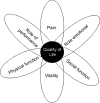Quality of life in patients with skull base tumors: current status and future challenges
- PMID: 20592852
- PMCID: PMC2853066
- DOI: 10.1055/s-0029-1242979
Quality of life in patients with skull base tumors: current status and future challenges
Abstract
In selection of the right treatment for a specific patient, the surgeon should consider not only the best approach to remove a tumor but also the impact of treatment on the quality of life (QOL) of the patient. Procedures involving extirpation of skull base tumors may be associated with high morbidity. It is therefore important to study patients with skull base neoplasms, because survival differences between various treatment modalities may be small, yet larger differences are expected regarding morbidity. The overall QOL in the majority of patients after skull base tumor resection can be classified as "good," with significant improvement taking place within 12 months following surgery. Patients with carcinomas, acoustic schwannoma, or Cushing's disease suffer from more significant deterioration in their QOL after any intervention. Data retrieved from disease-specific questionnaires revealed that the financial and emotional domains have the worse impact on patients QOL. Old age, malignancy, comorbidity, radiotherapy, and extensive surgery were found to be also negative prognostic factors for QOL. Pain control regimens, antidepressants, and other psychological modalities, including group support, can improve QOL measures in these patients. It is critical that surgeons understand that they cannot assess their patients' perspectives on QOL correctly without asking them. For adequate assessment, validated disease-specific instruments addressing multiple domains of QOL should be utilized.
Keywords: Quality of life; cancer; cranial base; craniofacial; neurosurgery.
Similar articles
-
Quality of life following surgery for anterior skull base tumors.Arch Otolaryngol Head Neck Surg. 2003 Dec;129(12):1303-9. doi: 10.1001/archotol.129.12.1303. Arch Otolaryngol Head Neck Surg. 2003. PMID: 14676156
-
Determinants of quality of life following resection of skull base tumors: a systematic review.Front Oncol. 2024 Dec 20;14:1473261. doi: 10.3389/fonc.2024.1473261. eCollection 2024. Front Oncol. 2024. PMID: 39759154 Free PMC article.
-
Quality of life following endoscopic resection of skull base tumors.J Neurol Surg B Skull Base. 2012 Apr;73(2):112-6. doi: 10.1055/s-0032-1301392. J Neurol Surg B Skull Base. 2012. PMID: 23542557 Free PMC article.
-
[Quality of life following anterior skull base surgery].Harefuah. 2004 Jul;143(7):489-93, 550, 549. Harefuah. 2004. PMID: 15669422 Hebrew.
-
Quality of life outcomes after endoscopic approaches to intracranial tumors.Curr Opin Otolaryngol Head Neck Surg. 2018 Feb;26(1):58-64. doi: 10.1097/MOO.0000000000000427. Curr Opin Otolaryngol Head Neck Surg. 2018. PMID: 29210717 Review.
Cited by
-
Changes Experienced in Quality of Life for Skull Base Surgical Patients: A Qualitative Case Study.J Neurol Surg B Skull Base. 2015 Mar;76(2):129-144. doi: 10.1055/s-0034-1371520. Epub 2014 Nov 6. J Neurol Surg B Skull Base. 2015. PMID: 28856080 Free PMC article.
-
A prospective evaluation of health-related quality of life after skull base re-irradiation.Head Neck. 2020 Mar;42(3):485-497. doi: 10.1002/hed.26037. Epub 2019 Dec 23. Head Neck. 2020. PMID: 31868271 Free PMC article.
-
Quality-of-Life after Anterior Skull Base Surgery: A Systematic Review.J Neurol Surg B Skull Base. 2014 Apr;75(2):73-89. doi: 10.1055/s-0033-1359303. Epub 2013 Dec 11. J Neurol Surg B Skull Base. 2014. PMID: 24719794 Free PMC article.
-
Treatment and Outcome of Patients with Skull Base Chordoma: A Meta-analysis.J Neurol Surg B Skull Base. 2014 Dec;75(6):383-90. doi: 10.1055/s-0034-1376197. Epub 2014 May 27. J Neurol Surg B Skull Base. 2014. PMID: 25452895 Free PMC article.
-
Quality of life reporting in the management of posterior fossa tumours: A systematic review.Front Surg. 2022 Sep 29;9:970889. doi: 10.3389/fsurg.2022.970889. eCollection 2022. Front Surg. 2022. PMID: 36303860 Free PMC article. Review.
References
-
- Gil Z, Abergel A, Spektor S, et al. Quality of life following surgery for anterior skull base tumors. Arch Otolaryngol Head Neck Surg. 2003;129:1303–1309. - PubMed
-
- Gil Z, Abergel A, Spektor S, Shabtai E, Khafif A, Fliss D M. Development of a cancer-specific anterior skull base quality-of-life questionnaire. J Neurosurg. 2004;100:813–819. - PubMed
-
- Gil Z, Patel S G, Singh B, et al. International Collaborative Study Group Analysis of prognostic factors in 146 patients with anterior skull base sarcoma: an international collaborative study. Cancer. 2007;110:1033–1041. - PubMed
-
- Langendijk H, Aaronson N K, de Jong J M, ten Velde G P, Muller M J, Wouters M. The prognostic impact of quality of life assessed with the EORTC QLQ-C30 in inoperable non-small cell lung carcinoma treated with radiotherapy. Radiother Oncol. 2000;55:19–25. - PubMed
-
- Movsas B. Exploring the role of the radioprotector amifostine in locally advanced non-small cell lung cancer: Radiation Therapy Oncology Group trial 98-01. Semin Radiat Oncol. 2002;12(1, Suppl 1):40–45. - PubMed
LinkOut - more resources
Full Text Sources
Medical


